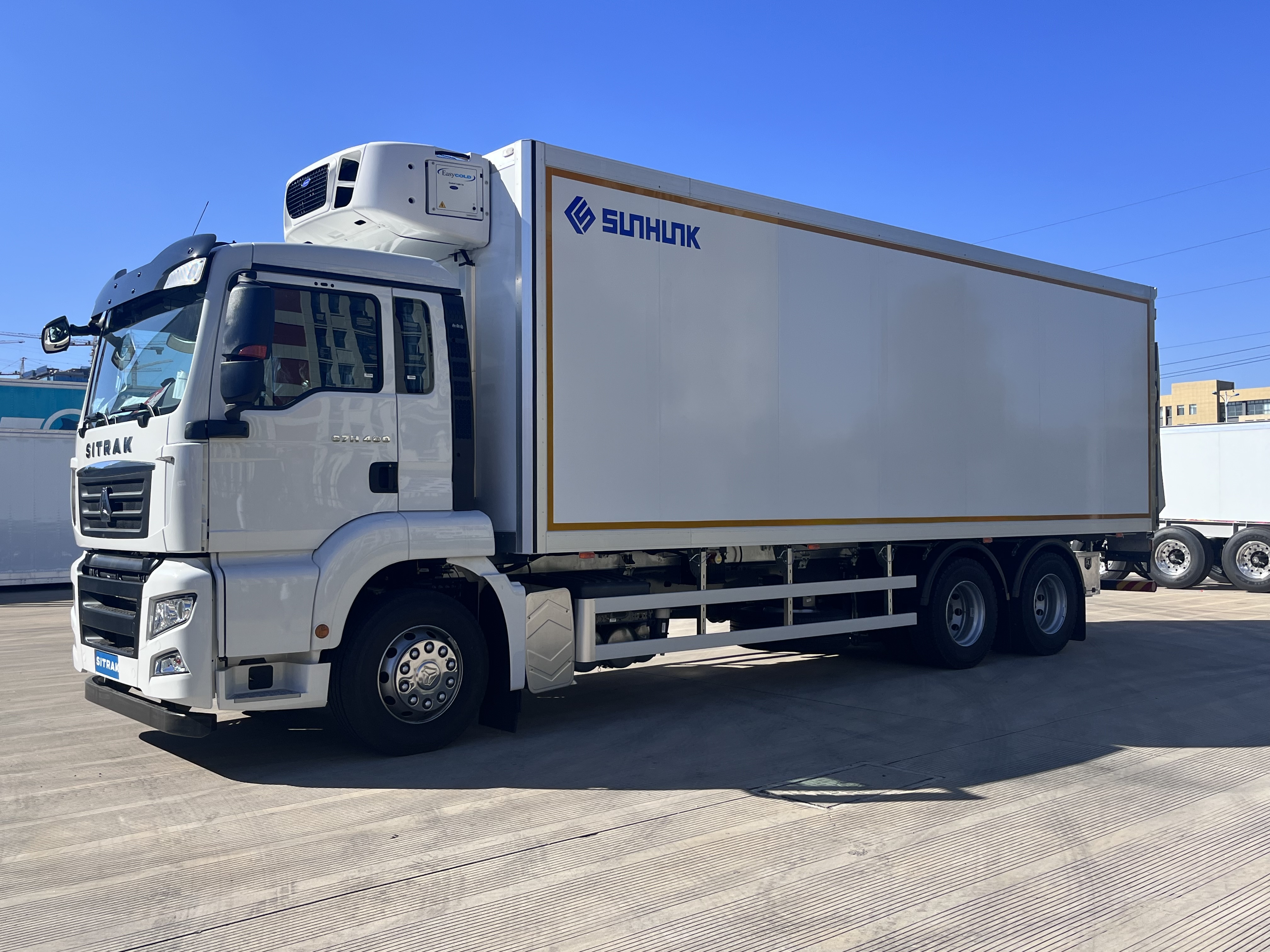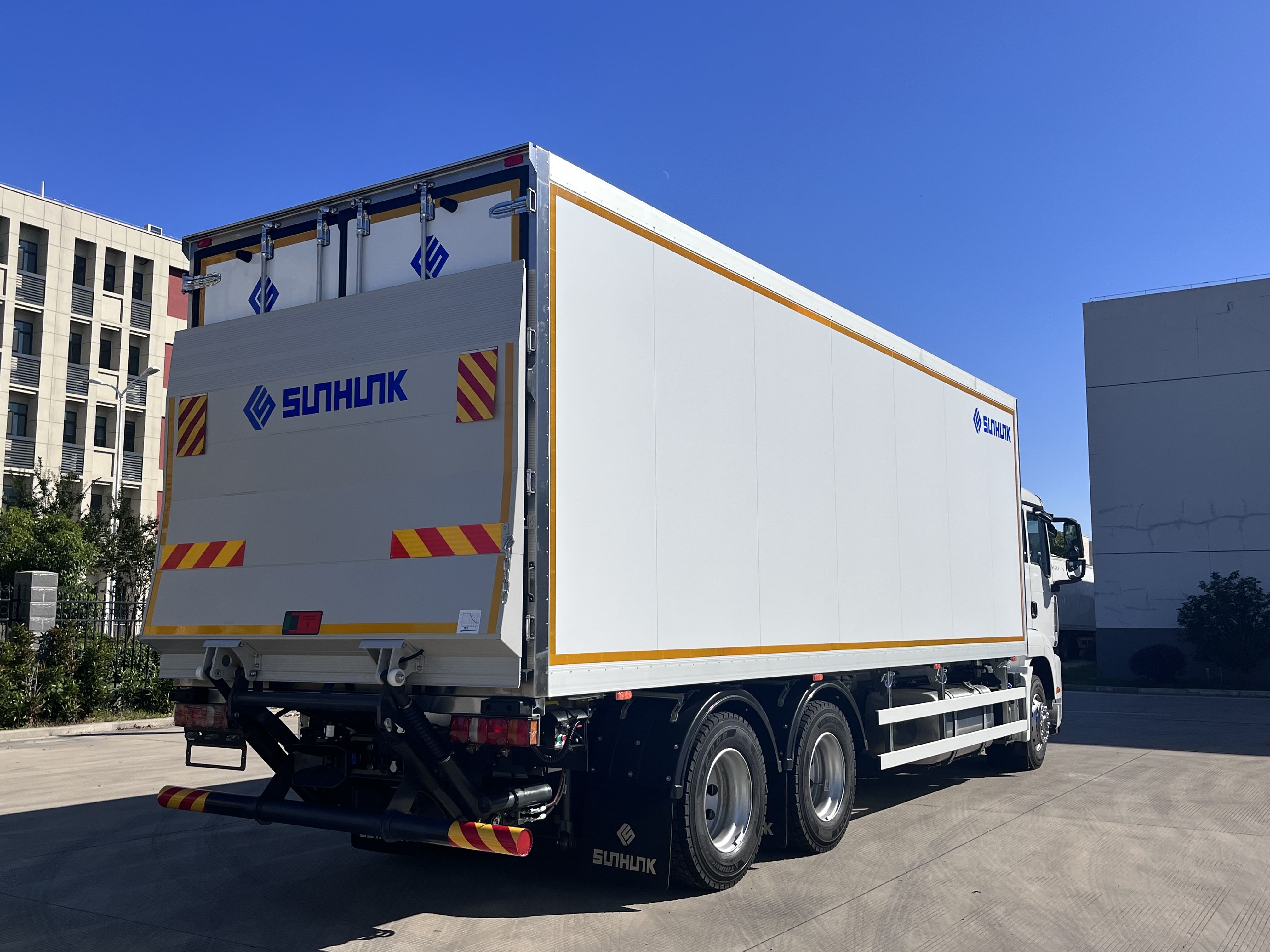- PRODUCTS
- SOLUTION
- SERVICE
- NEWS
- ABOUT US
A refrigerated truck is comprised of a body, the cooling unit itself (the compressor), insulation materials, air ducts, and an energy system. The body is assembled using 1.5 mm thick high-strength steel plates and uses a total insulation thickness of 80 mm; thermal conductivity reaches up to Λ ≤0.02 W/m·K. The refrigeration system has great performance with a cooling capacity of 5000 BTU/h when the temperature in the compartment drops from ambient +10°C to -20°C in less than 15 minutes. With the even flow of cold air throughout, not exceeding an internal temperature differential range as wide as 2°C, it is able to sustain and reach a very nominal cargo surrounding during transportation.
The mobile cold room body uses standard new materials, 1.2 mm-1.5 mm high-strength steel or aluminum alloy with reinforcement (good impact and corrosion resistance). Taking a refrigerated truck produced by an internationally renowned brand as an example, the strength of the 6061-T6 aluminum alloy plate can be up to 290 MPa (510 times that of ordinary steel), which is also 30% lighter than common low-carbon steels. The body is insulated with 50 mm-100 mm thick polyurethane foam, which has a low thermal conductivity of only 0.02 W/m·K, thus preventing heat transfer and maintaining the temperature in the compartment at a low level inside.
The thermal insulation effect of the refrigerated truck vehicle primarily lies in the choice of its insulating materials. Polyurethane foam typically has a density of 40–60 kg/m³ (rising to as high as 80 kg/m³ with more insulation) and represents the least expensive option. For large logistics companies, the refrigerated truck compartment inside layer insulation thickness is generally 80 mm polyurethane foam. In tests conducted at an external temperature of 35°C, the box maintained a constant internal compartment temperature of -18°C. Additionally, vacuum insulation panels, which have even lower thermal conductivities (0.004 W/m·K), though also cost more to add, are generally reserved for higher premium freight such as pharmaceuticals with extremely strict requirements on thermal oscillations during transportation.
The door is a key part of the refrigerated truck and greatly influences the heat preservation effect in the compartment. The refrigerated truck door is generally made of a multilayer structure, which includes a 50 mm thick insulation material, and both the interior and exterior sides are equipped with EPDM rubber sealing strips. These sealing strips are superior to common rubber strips, with a sealing performance attenuation rate of less than 5%, and can be used at temperatures ranging from -50°C to 150°C. A separate test carried out by one specific brand's refrigerated truck involved freezing the truck continuously 10 times with door openings in between. Each time, the compartment's internal temperature increased only by 2°C, ensuring cold chain transport is well maintained.

Refrigeration system and temperature control system
The main parts of the refrigeration system in a refrigerated truck include the compressor, condenser, evaporator, and expansion valve. Carrier Transicold's refrigeration system uses a scroll compressor that offers a cooling capacity of 5000 BTU/h, which is enough to decrease the compartment temperature from +10°C to -20°C in about 15 minutes. Liquid nitrogen refrigeration systems work by using evaporated liquid nitrogen to absorb heat, with every liter of liquid nitrogen absorbing 500 kcal of heat. According to data from an established multinational logistics company, using a liquid nitrogen refrigeration system, within 30 minutes of parking at an ambient temperature of -40°C, the compartment can maintain a temperature below -20°C, ensuring the safe transport of goods that require such conditions.
Modern refrigerated trucks are also equipped with smart temperature control systems, such as those fitted by Thermo King. These intelligent temperature control systems record the environment's temperature in real-time at different spots within the compartment through multiple entry-point sensors, with detection accuracy as high as ±0.5°C. When any location within the storage unit's reach fails to detect scheduled data properly, the system itself will automatically adjust power levels to ensure the temperature remains within the proper limits. In a transportation company, the temperature system is equipped with four data detection points inside the compartment, and GPS monitoring ensures that temperature fluctuations during transport stay within a range of ±2°C, thus protecting the quality of the cargo.
The design of the air ducts plays a crucial role in the even distribution of cold air throughout the compartment. In a well-known brand of refrigerated trucks, an air duct system with double layers is arranged at the top and sides of the compartment to provide good airflow organization. This design is based on the principles of transport cooling using Computational Fluid Dynamics (CFD) to ensure a natural perfusion mix, maintaining flow speeds between 0.5–1.0 m/s, thus avoiding localized overcooling or overheating. This design allows the refrigerated van to adjust the temperature by 2°C during long-distance transportation, offering flexibility and energy savings.

Vehicle floor and energy system
The floor of the refrigerated truck is typically composed of 2 mm thick high-strength steel plates that are covered with a polyurethane board, which has a thickness of 50 mm to prevent heat from coming from the ground. A refrigerated truck floor from a certain brand adopts a double-layer structure, with a non-slip aluminum alloy plate on the surface layer and a cork leather-PUF multi-composite material sandwich design, which can increase heat insulation performance by approximately 15% compared to a single-layer construction. During tests, a refrigerated truck with this floor system passing through a 50°C road thermal environment only experienced a 1°C increase in the compartment's temperature, effectively ensuring the cold chain transportation of cargo.
Most refrigerated trucks with traditional cold chain logistics systems use the power output from the vehicle's engine to drive the refrigeration system. However, considering contemporary factors like sustainability and environmental impact, independent electric drive systems have gained more attention. One particular brand has introduced a refrigerated truck equipped with a 30 kWh lithium battery pack, ensuring the refrigeration system can run independently for ten hours at full charge, making it ideal for long-haul transport. The system also allows for solar-assisted charging to supplement the battery, and experiments have demonstrated up to 15% additional power in good sunlight conditions, effectively extending the refrigeration system's operation time.